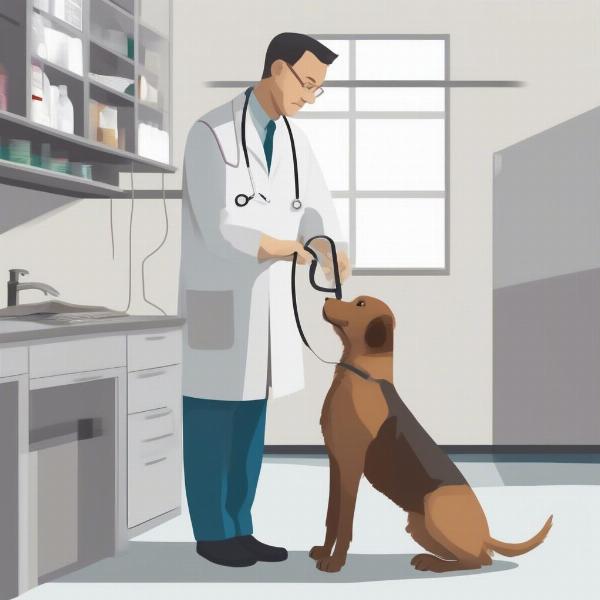Grain-free dog food has become increasingly popular in recent years. Many pet owners believe it offers several health benefits, particularly for dogs with allergies or sensitivities. But what exactly is good grain-free dog food, and how can you choose the best option for your furry friend? This comprehensive guide will delve into everything you need to know about selecting a high-quality, grain-free diet for your dog.
Understanding Grain-Free Dog Food
What does “grain-free” actually mean? It signifies the absence of grains like wheat, corn, rice, barley, and oats. These grains are often used as fillers in cheaper dog foods. Good grain-free dog food substitutes these with alternative carbohydrate sources such as sweet potatoes, potatoes, peas, lentils, or tapioca. This can be beneficial for dogs with grain allergies or intolerances, which can manifest as skin issues, digestive problems, or other health concerns.
Benefits of a Grain-Free Diet
Is grain-free dog food right for your canine companion? For some dogs, eliminating grains can lead to improved digestion, healthier skin and coat, and increased energy levels. This is particularly true for dogs with sensitivities. However, it’s crucial to remember that not all dogs require a grain-free diet. If your dog thrives on a diet containing grains, there’s no need to switch.
Choosing the Right Grain-Free Dog Food
Selecting the best grain-free dog food can be overwhelming with so many options available. Look for foods that prioritize high-quality animal protein as the primary ingredient. Avoid foods with artificial colors, flavors, and preservatives. Check the ingredient list carefully for potential allergens. Consider your dog’s age, breed, activity level, and any specific health needs.
How to Transition to a Grain-Free Diet
Switching your dog to a new food should be done gradually to avoid digestive upset. Start by mixing a small amount of the new grain-free food with their current food. Slowly increase the proportion of grain-free food over several days until the transition is complete. Monitor your dog closely for any signs of digestive issues, such as vomiting or diarrhea.
Is Grain-Free Dog Food Safe?
While generally safe, there have been some concerns raised about a potential link between grain-free diets and dilated cardiomyopathy (DCM) in certain breeds. More research is ongoing to understand this potential connection. Consult with your veterinarian before switching to a grain-free diet, especially if your dog has any pre-existing health conditions.
 Veterinarian Examining a Dog
Veterinarian Examining a Dog
What if My Dog Doesn’t Like Grain-Free Food?
Not all dogs enjoy the taste of grain-free food. If your dog refuses to eat their new grain-free kibble, try adding a small amount of warm water or low-sodium broth to make it more palatable. You can also try mixing in a small amount of wet grain-free food. If your dog continues to refuse the food, consult with your veterinarian or a certified pet nutritionist.
Conclusion
Choosing good grain-free dog food involves careful consideration of your dog’s individual needs and preferences. Prioritize high-quality ingredients, consult with your veterinarian, and transition slowly to minimize digestive upset. By following these guidelines, you can help ensure your furry friend enjoys the potential benefits of a grain-free diet. Remember, a healthy diet is crucial for a happy and energetic dog.
FAQ
- Is grain-free dog food suitable for all breeds? While generally safe for most breeds, consult your vet, especially for breeds with a predisposition to DCM.
- What are the common signs of grain allergies in dogs? Skin irritations, itching, digestive problems, and ear infections can be signs of grain allergies.
- Are all grain-free dog foods created equal? No, the quality of ingredients and nutritional balance varies significantly. Always choose high-quality options.
- How much grain-free food should I feed my dog? Follow the feeding guidelines on the packaging and adjust based on your dog’s individual needs.
- Can puppies eat grain-free food? Yes, there are grain-free puppy formulas available. Consult your veterinarian for recommendations.
- Is grain-free dog food more expensive? Generally, yes, due to the higher quality ingredients often used.
- What are some good alternatives to grains in dog food? Sweet potatoes, potatoes, peas, lentils, and tapioca are common grain substitutes.
orijin dog food
instinct lamb dog food
ILM Dog is your one-stop resource for expert advice on all aspects of dog care, from breed selection and nutrition to training and health. We offer practical, trustworthy information to help dog owners worldwide provide the best possible care for their canine companions. From choosing the right hi point zero dog food to understanding the best dog food for staffordshire terrier, we’ve got you covered. montego dog food review also provides valuable insights. Contact us at [email protected] or +44 20-3965-8624 for personalized advice.